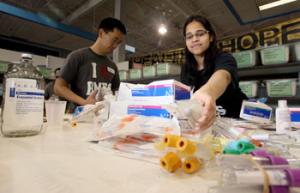Dominique Lim spent the better part of her life in a country where diseases that modern medicine have made practically unheard of are commonplace.
In her native Philippines, a country with a population soaring past 90 million in an area slightly larger than the state of Arizona, lack of healthcare and ill-equipped hospitals make ailments such as typhoid and tetanus more prominent.
With two parents in the medical field, Lim, now a University of Houston junior, had a first-hand look at these realities during 17 years in the country just southeast of mainland Asia.
“I remember most hospitals would be understaffed,” said Lim of her time in Manila, the country’s capital. “They definitely did not have state-of-the-art medical equipment, and most of the rural area hospitals would be under a one-roofed building with concrete walls. There would be community rooms where about 20 patients would be sharing the room without dividers; some would even share beds. Some days they wouldn’t even have water or electricity at the hospitals for as long as weeks at a time.”
Close to the Heart
Lim’s experience in the Philippines, in part, is why she chose to pursue a degree in biomedical engineering, enrolling at UH several months after her family moved to Houston in 2004.
Late last year, when Lim stumbled across Project Cure—a nonprofit organization dedicated to collecting and shipping medical items to hospitals and clinics in Third-World countries—she knew it was the perfect place for her to learn and give back. A summer internship with the charity inspired her to get her classmates involved, too.
As president of the UH Biomedical Engineering Society, Lim took members to the charity’s northwest Houston warehouse for the first time at the start of the fall semester. It’s been a regular stop for the student organization ever since.
During monthly visits, engineering students devote hours sorting and testing the vast amount of medical supplies and equipment that arrive at the facility on empty Wal-Mart trailers from hospitals across the country.
Disposable contributions such as gauze, saline and gloves are typically surplus for donors while the equipment is more often hospital-leftovers—long since replaced by newer models. Most of the machines are still usable and better than what many of these countries have or could afford. All are tested to be sure, and equipment not meeting standards is either tossed or repaired by tech savvy students and other volunteers.
On the trip the end of January, Audrey Cheong and Angela Man, both sophomore biomedical engineering majors, were hidden among the rows of donated fetal monitors, EKG machines and diagnostic sets lining the back of the warehouse. The two women were eyeing a lab microscope—studying the settings and ensuring the tool could properly focus on one of their test slides.
For Man, who was experiencing her first visit with the UH group, the trip was not only a great outreach project, but also a way to further her education.
“I want to go to medical school to be a surgeon,” said Man fiddling with the slide. “It’s a good cause and great way to learn about some of the equipment before I make it to medical school.”
Delivering Hope Miles Away
The charity’s Houston location and three other facilities across the country ship two 40-foot containers—roughly the size of a semi trailer—filled with supplies to health care providers in more than 120 developing countries every week, said Lane Gibson, operations director for the local facility. Over half of the contents shipped in these containers are basic, disposable supplies. The rest is equipment.
In most cases, hospitals get an entire container to themselves, and sometimes two clinics may split one. In either case, supplies go quick, Gibson said.
“There is such a huge desperate need for this stuff,” he said. “We shipped two, 40-foot containers to a hospital in the northern part of Iraq about six months ago. The one hospital went through all of the disposables, things like syringes, dressings and disposable gloves in two weeks.”
On the other side of the facility from Cheong and Man, the majority of the biomedical engineering students were working with nurses to ready disposable supplies. Teams of two and three students were grabbing boxes and bags stuffed with everything from blood pressure cuffs to tubing and sorting them into bins. The items would later be packaged into kits specific for work in surgery or with trauma cases.
Sheetal Shah, a sophomore biomedical engineering major and aspiring brain surgeon, was halfway into a trash-can-sized plastic bag of supplies. Like Lim, experiences in Shah’s own life allowed her to relate to her volunteer work with Project Cure.
“I lived in Bombay, India for six years,” Shah said. “Every time you would drive down the street you would see the poor, the poverty. It was hard to look at. When I was there, that’s when I knew I had to go into the medical field.”
For John Wilson, a junior biomedical engineering major, a summer internship at the charity alongside Lim helped him learn a little more about life outside the Lone Star state.
“It has opened my eyes,” he said of the service work. “I never knew conditions of hospitals in Third-World countries. It’s nothing like what’s around here—some of the biggest and best medical facilities. It makes you realize how many things we take for granted in America.”
